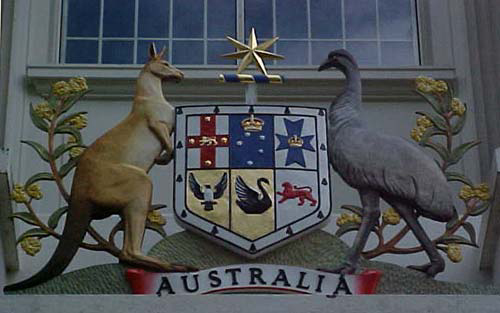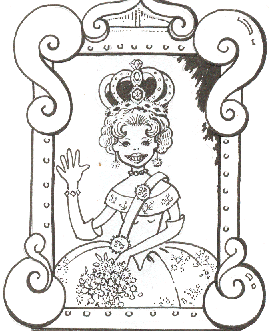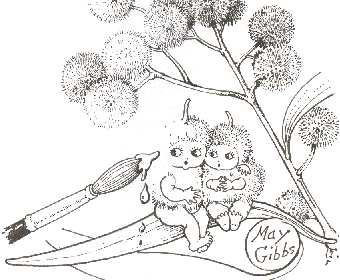You could plant two or three different wattles for every day of the year, and still have plenty over, for Australia has more acacia species than the year has days.
In Australia, the wattles are the largest genus of flowering plants. Of the 1380 species of acacia in the world, Australia has about 985. And in Australia acacias are the extremely diverse - found in habitats from rainforest to arid lands. The largest numbers of species are found in the semi-arid wheatbelt region of Western Australia but high numbers also occur associated with the rocky tablelands of the Great Divide in eastern Australia. Although species numbers are generally lower in the inland desert regions, it is here that Wattles are King with species like Mulga (Acacia aneura) dominating the landscape for hundreds and hundreds of kilometres. Wattles range in size from mat-like creepers (e.g. Acacia aculeatissima and pulviniformis) to tall forest trees (e.g. Acacia bakeri and Acacia celsa). Most, however, are shrubs or small trees between about 1 and 5 metres tall (e.g. Acacia acinacea and Acacia acuminata).
Botanists still ponder the question as to why there are so many different species of wattle in Australia. Why in Australia is there such wattle diversity?
Australians may have made a home for themselves amongst the gumtrees, but it is the wattletree that has found its way into Australian symbolism. Most Australians can recognise a wattle, at least when it is in flower. In the years leading up to Federation in 1901, the Australian Natives Association (ANA) began a campaign to find a national flower as an emblem for Australia like the rose for the English, the thistle for the Scots, leeks for the Welsh and the shamrock for the Irish. The Canadians had just recently chosen their maple. The wattle was the choice, the ANA committee said, as it was not excluded from any part of Australia, had bright beauty and was useful in tanning hides! The wattle was being called upon to represent an egalitarian, classless Australia of golden prosperity. Wow!

The Golden Wattle (Acacia pycnantha) is now the official floral emblem of Australia, wattle blossoms are to be found on the Australian Coat of Arms, and the Order of Australia is in the shape of a single wattleblossom. Australian Olympic athletes wear wattle inspired green and gold uniforms. A Governor General, Sir William Deane, took wattle blossoms to Switzerland to commemorate young Australians who died there and Prime Minister John Howard wore sprigs of wattle at ceremonies after the Bali bombings.

 Schools
and other communities celebrate Wattle Day on the first day of September
-Spring- when most wattles come into flower in the more populated parts
of Australia, as the days get longer and warmer. Wattle Park in Melbourne
began in such a way. Around the time of the First World War, the local
community got together and planted 12,000 wattle seedlings - in a mammoth
gesture of wattle nationalism. Artists draw and write about wattles.
May Gibbs created children's books with wonderful wattle characters.
Historians quote the poet Henry Lawson who first used the expression
'if blood should stain the wattle' in a poem about class wars in 1891.
This metaphor was adapted again by Bruce Elder in Blood on the Wattle:
massacres and maltreatment of Australian Aborigines since 1788.
The gold of the wattle and the red of the blood he said reflected the
then new Aboriginal flag.
Schools
and other communities celebrate Wattle Day on the first day of September
-Spring- when most wattles come into flower in the more populated parts
of Australia, as the days get longer and warmer. Wattle Park in Melbourne
began in such a way. Around the time of the First World War, the local
community got together and planted 12,000 wattle seedlings - in a mammoth
gesture of wattle nationalism. Artists draw and write about wattles.
May Gibbs created children's books with wonderful wattle characters.
Historians quote the poet Henry Lawson who first used the expression
'if blood should stain the wattle' in a poem about class wars in 1891.
This metaphor was adapted again by Bruce Elder in Blood on the Wattle:
massacres and maltreatment of Australian Aborigines since 1788.
The gold of the wattle and the red of the blood he said reflected the
then new Aboriginal flag.
Even The Queen has a favourite brooch, a Golden Wattle blossom brooch, that she wears when she wishes to identify with Australia. And her 1954 coronation dress was embroided with golden wattle, along with all those other flowers of the Commonwealth.
It is said you can find a wattle in flower somewhere in Australia at any time of the year. And in coming to know and recognise the variety of wattles in Australia, you can come along way in understanding and appreciating the Australian bush and its people.
Wattle you know wattle you do?
- How many wattle species do botanists think there are in the world? In Australia? Compare this with the number of Eucalypts. Why is yellow and green chosen as the Australian Olympic uniform colours?.Can you find the wattle hiding on a 50c coin by doing a coin rubbing?
- Find story books on wattles in library such as 'Okra and Acacia: the story of the Wattle Pattern Plate' by Libby Hathorn
- Wattles as emblems: www.anbg.gov.au/emblems/
- Wattles as fashion: www.fashion-era.com/images/SocialHistory/corodrsdetail.jpg
- Wattles as fantasy: www.maygibbs.com.au
- Wattles in recipes: www.kuranga.com.au
- Wattle Day: http://www.worldwidewattle.com/infogallery/symbolic/wattleday.php
- Wattle poems - write some like Kim (age 12) below
Wattle-Cycle
As the wind blows slightly
And the sun shines brightly
It's rays lead to a tree
Standing ever so magnificently.
Twisted branches produce clusters of flowers,
The colour of honey - worth lots of money.
Surrounded by leaves pointy and green,
But now it's winter, with no colour to be seen.
Twisted branches produce nothing but fingers
Reaching to grab any summer that lingers.
The wind begins to blow and the tree starts to sway,
The roots start to go, they cannot stay.
The days pass slowly, 'til one fine morn
The wind stops … and a new tree is born.
Twisted branches produce clusters of flowers,
The colour of honey - worth lots of money.
Surrounded by leaves, pointy and green,
And that's how the life-cycle of a wattle has always been.
Wattles
Wattles have flowers, big and small,
Some plants are short, some quite tall.
They grow in the bush, they grow in your home,
Some in clusters, some on their own.
They need no help to grow or survive,
Anything can grow on 'em - even a bee-hive.
So come on! Do as I say,
Go buy a Wattle, tomorrow or today!